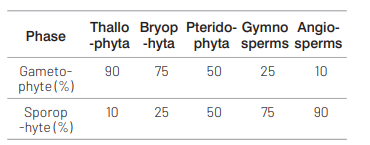Question
Male and female gametophytes do not have an independent free-living existence in [NEET (Oct.) 2020]
(a)pteridophytes
(b)algae
(c)angiosperms
(d)bryophytes
Answer/Explanation
Ans. (c)
Male and female gametophyte do not have an independent free-living existence in gymnosperms and angiosperms. In them they remains within the sporangia retained on the sporophytes. The pollen grain is released from the microsporangium and are carried in air currents and come in contact with the opening of the ovules borne on megasporophylls. The pollen tube carrying the male gametes grows towards archegonia in the ovules and discharge their contents near the mouth of the archegonia.
Question
Which is the most common type of embryo sac in angiosperms? [NEET (Odisha) 2019]
(a) Tetrasporic with one mitotic stage of divisions
(b) Monosporic with three sequential mitotic divisions
(c) Monosporic with two sequential mitotic divisions
(d) Bisporic with two sequential mitotic divisions
Answer/Explanation
Ans. (b)
The most common type of female gametophyte (embryo sac) in angiosperms is the monosporic embryo sac in which the embryo sac develops from a single functional megaspore (n) while the other three megasproes degenerate. The functional megaspore undergoes three sequential mitotic divisions and gives rise to 8 -nucleate and 7-celled mature embryo sac.
Question
Male gametophyte with least number of cells is present in [CBSE AIPMT 2014]
(a) Pteris
(b) Funaria
(c) Lilium
(d) Pinus
Answer/Explanation
Ans. (c)
Lilium (angiosperm) possesses the male gametophyte with least number of cells.
The number of cells in male gametophyte shows the pattern of reduction from bryophytes to angiosperms. In angiosperms, it is reduced to about 2-3 celled and called as pollen grains.
The number of cells in male gametophyte decreases in the following order
Funaria $>$ Pteris $>$ Pinus $>$ Lilium
Question
Compared with the gametophytes of the bryophytes, the gametophytes of vascular plants tends to be [CBSE AIPMT 2011]
(a) larger but to have smaller sex organs
(b) larger and to have large sex organs
(c) smaller and to have smaller sex organs
(d) smaller but to have larger sex organs
Answer/Explanation
Ans. (c)
As we proceed from thallophyta to angiosperms, there is gradual reduction in gametophyte with reduced size of sex organs. From thallophyta to angiosperms, there is progressive elaboration of sporophytes.

Question
Conifers differ from grasses in the [CBSE AIPMT 2006]
(a) lack of xylem tracheids
(b) absence of pollen tubes
(c) formation of endosperm before fertilisation
(d) production of seeds from ovules
Answer/Explanation
Ans. (c)
The conifers (gymnosperm) differ from the grasses (angiosperm) in the formation of endosperm before fertilisation. Infact, in gymnosperms, the endosperm is a haploid tissue as it formed before fertilisation, while in angiosperms, endosperm is formed after fertilisation as a result of triple fusion or double fertilisation, thus, it is a triploid tissue.
In both conifers and grasses seeds are produced from ovules.
Xylem tracheids are present in both conifers and grasses.
Pollen tubes are also formed in both conifers and grasses.
Question
Angiosperms have dominated the land flora primarily because of their [CBSE AIPMT 2004]
(a) power of adaptability in diverse habitat
(b) property of producing large number of seeds
(c) nature of some pollination
(d) domestication by man
Answer/Explanation
Ans. (a)
Angiosperms are well adapted to terrestrial life and occur in diverse habitats like cold tundra to hot tropical and even desert areas. They also thrive well in aquatic habitat. Hence, they being the most successful, to have dominated the land flora.
Question
Which of the following is without exception in angiosperms? [CBSE AIPMT 2002]
(a) Presence of vessels
(b) Double fertilisation
(c) Secondary growth
(d) Autotrophic nutrition
Answer/Explanation
Ans. (b)
A few plants, (e.g. Rafflesia) are parasitic. Some angiosperm genera are vesselless. Secondary growth does not take place in a large variety of angiosperms. However, double fertilisation is met with amongst all angiosperms.
In this one male gamete fuses with egg nucleus(n). This is known as syngamy and the second male gamete fuses with the secondary nucleus or polar nuclei $(2 n)$. This is known as triple fusion. Together these syngamy and triple fusion is known as double fertilisation.
